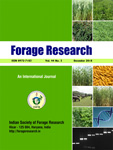GULAB PANDOVE*, NIRMAL SINGH, AMANDEEP SINGH SIDHU AND AMAN PREET
School of Organic Farming, Punjab Agricultural University, Ludhiana-141 004 (Punjab), India
Department of Microbiology, Punjab Agricultural University, Ludhiana-141 004 (Punjab), India
*(e-mail: gpandove@pau.edu)
(Received: 2 June 2025; Accepted: 29 June 2025)
SUMMARY
Biogas slurry is a by-product of anaerobic digestion, it can act as a valuable organic fertilizer as it is enriched with essential plant nutrients and beneficial microorganisms. It can serve as an efficient soil conditioner, enhance fertility, improve crop productivity, and support eco-friendly farming practices. The application of biogas slurry improves soil structure by increasing aeration, water retention, and nutrient availability, thereby fostering healthier plant growth. Since the slurry undergoes anaerobic decomposition, it reduces unpleasant odours and suppresses harmful pathogens, making it a safer alternative to raw manure. The microbial population in biogas slurry includes nitrogen-fixing bacteria, phosphate-solubilizing microbes, and plant growth-promoting bacteria, along with various enzyme-producing organisms that contribute to organic matter breakdown and nutrient release. Additionally, biogas slurry has been observed to exhibit antifungal properties, which can aid in controlling plant pathogens and enhancing crop resistance. This review will focus on the following aspects: microbiome of biogas slurry, Physico-chemical properties of biogas slurry, Impact of biogas slurry on crop productivity and quality, application method of biogas slurry, Impact of biogas slurry on soil health, pest disease resistance and antifungal potential of biogas slurry. The insight gained from the litrature reviewd herein will further assist the scientific community in exploring the potential of biogas slurry across a range of forage crops.
Key words: Beneficial microorganisms, biogas slurry, enzymes, nitrogen-fixing bacteria, pathogens

